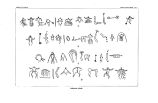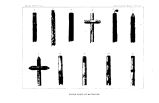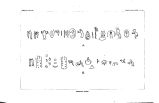| OCR Text |
Show BOmiiH.] INDIAN SONGS. 289 something of European origin, as exemplified in the specimen illustrated on PI. xxi, Nos. 1 and 2, showing both the obverse and reverse. The specimen is made of ash wood and measures about ten inches in length. On the obverse side, besides the figures of man'- idos, such as the Thunder bird, the serpent, and the tortoise, there is the outline of the sun, spots copied from playing cards, etc.; upon the reverse appear two spread hands, a bird, and a building, from the top of which floats the American flag. This specimen was found among the effects of a Mide' who died at Leech Lake, Minnesota, a few years ago, together with effigies and other relics already mentioned in another part of this paper. MUSIC. In addition to the examples of Indian music that have been given, especially the songs of shamans, it may be of interest to add a few remarks concerning the several varieties of songs or chants. Songs employed as an accompaniment to dances are known to almost all the members of the tribe, so that their rendition is nearly always the same. Such songs are not used in connection with mnemonic characters, as there are, in most instances, no words or phrases recited, but simply a continued repetition of meaningless words or syllables. The notes are thus rhythmically accentuated, often accompanied by beats upon the drum and the steps of the dancers. An example of another variety of songs, or rather chants, is presented in connection with the reception of the candidate by the Mide' priest upon his entrance into the Mide'wig& n of the first degree. In this instance words are chanted, but the musical rendition differs with the individual, each Mide' chanting notes of his own, according to his choice or musical ability. There is no set formula, and such songs, even if taught to others, are soon distorted by being sung according to the taste or ability of the singer. The musical rendering of the words and phrases relating to the signification of mnemonic characters depends upon the ability and inspired condition of the singer; and as each Mide' priest usually invents and prepares his own songs, whether for ceremonial purposes, medicine hunting, exorcism, or any other use, he may frequently be unable to sing them twice in exactly the same manner. Love songs and war songs, being of general use, are always sung in the same style of notation. The emotions are fully expressed in the musical rendering of the several classes of songs, which are, with few exceptions, in a minor key. Dancing and war songs are always in quick time, the latter frequently becoming extraordinarily animated and boisterous as the participants become more and more excited. Mide' and other like songs are always more or less monotonous, though they are sometimes rather impressive, especially if delivered 7 ETH 19 |














































































































































































































































































































































































































